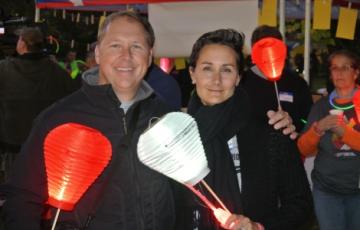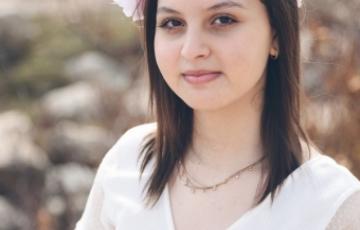Search Results

Andrea
In October 2015, my family had just moved to Texas for a new start. I had a new career, and two young boys ― a 2-year-old and a 7-year-old.
I wasn’t feeling well and went to urgent care one day where we discovered my white blood cell count was 113. They sent me straight to the ER where I was all alone because we had no one here yet and couldn’t bring the kids to the hospital. Three days later, I was diagnosed with chronic myeloid leukemia (CML).

Christen
Originally from northern New York, Christen moved to Denver, Colorado, in 2015 after completing her Bachelor of Science of Nursing at Le Moyne College to pursue a career in cancer care. Through a close relationship with her grandparents, she saw how her grandma, a retired registered nurse, graciously cared for her grandpa while he lived with esophageal cancer for close to a decade. The unwavering love, dedication, and courage they shared inspired Christen to seek out a specialty that allowed her to provide compassionate, holistic care to those in need.

Nik
Hello, my name is Nikolas. I am 16 years old, almost 17, and have been battling acute lymphoblastic leukemia (ALL) for eight years.

Jessica
I'm a 32-year-old woman, and I battled stage III nodular sclerosis Hodgkin lymphoma (NSHL) from ages 27 to 29. It started with the base of my throat being enlarged to experiencing every symptom you could possibly get from this disease as I was misdiagnosed for a year straight. My cancer was diagnosed as . . . wait for it . . . allergies. For a year. Once I was officially diagnosed in October 2021, I had my staging PET scan which revealed I was riddled with tumors in my head, neck, chest, and near my liver.
Jaziel
Hello, my name is Jaziel, and I am a three-time leukemia survivor. My story began in 2008 when I was initially diagnosed with acute lymphoblastic leukemia (ALL). I was treated for a few years and became cancer-free (remission) in 2011. During my first battle with cancer, The Leukemia & Lymphoma Society (LLS) helped me and my family immensely by assisting us with rent, gas, and sometimes simply sharing the stories of other survivors, encouraging me to keep fighting.

LLS Researchers
Partnering for Cures – Our Unique Collaborations Span Continents

Amanda
The word “warrior” seems too tame to describe Amanda Monteiro, a volunteer with The Leukemia and Lymphoma Society (LLS). She’s fueled by her desire to prevent another child from being diagnosed, another parent from having to say goodbye.

Deanna
Within 24 hours of going to the local emergency room in New York, I found myself being admitted to the Dana Farber/Brigham Women's Cancer Center in Boston. It was August of 2013 and I was exhausted beyond anything my four kids could inflict upon me and shocked to find out it wasn't anemia, I had acute lymphoblastic leukemia (ALL).

Andrew
In 2015, I was living in New York City and noticed a lump under my left armpit when I was in the shower. Nobody likes to go to the doctor to talk about strange bodily findings, so I waited for a few months to see if it would magically go away on its own. It didn't. I finally worked up the courage to make a doctor appointment. I showed the lump to my primary care physician, and he said, "Andrew, that's why you came to see me? Just change your deodorant, and you'll be fine." I'm a nice Jewish boy from the Midwest, so I trust doctors implicitly.

Lauren
After being diagnosed Hodgkin’s lymphoma at age twenty-two, my battle with cancer led to a very unexpected journey in my life: becoming an author. I’m very grateful to share that I’ve now been cancer-free for eight years, and my debut fantasy novel The Memory Thief was published by HarperCollins in October of 2019.

Ethar
Refugee Family Gives Back to LLS after Daughter Survives Leukemia
Sixteen-year-old Ethar and her family moved to the United States from Iraq in 2015. Just one year later, she was diagnosed with T-cell acute lymphoblastic leukemia.
“It all started when my lymph nodes began to swell and the pain became very intense,” said Ethar. “It was at this point, that I went to the emergency room with my father so we could try to make sense of what was happening to me.”

Erin
The night of May 21, 2014, looked like any other that my roommate, Erin, and I would have in our San Francisco apartment. I was busy making the next day's lunch when Erin came home and joined me in the kitchen. We caught each other up on our days, cooked, laughed and planned our next fun adventure. I casually asked how her doctor appointment had gone that day. That’s when she told me that she had been diagnosed with Hodgkin lymphoma. A day that looked so normal was anything but.

Cynthia
Cynthia was on a family vacation in 2015 when she began experiencing back pain so severe that she had to be in a wheelchair for the rest of the trip. When she returned home, Cynthia went to see her doctor who referred her to an oncologist. After several tests, Cynthia was diagnosed with multiple myeloma. She was devastated. Chemotherapy and radiation soon followed, along with horrible side effects, sleepless nights and countless blood transfusions. But Cynthia was not going to let cancer defeat her.
Gina
In November 2016, Gina was diagnosed with Stage II Hodgkins lymphoma (nodular sclerosis). She had just started her second year at Massachusetts College of Pharmacy and Health Sciences where she studies diagnostic medical imaging in the sonography program which is an accelerated three year bachelor program. In addition to being a full time student, she works Friday evenings and 10 hour shifts on Saturday and Sunday at an Urgent Care Center.

Kessler
Kessler McLaughlin’s life change forever on July 13, 2006. In the months leading up to that day, he was a typical 14-year-old kid, except that he was in pain all the time. Doctors couldn’t figure out why his joints were in so much pain.

Starlet
When I was born, I was healthy and hardly ever got sick. Well, when I turned one, I had fevers that would come and go and then my mom started to notice I would limp and bruise easily. My mom decided to take me to the hospital after a persistent fever and the limping and bruising got worse. The doctors then referred us to Valley Children’s where they did blood work on me.
After the results came in my parents heard the words no one ever wants to hear: their one-year-old daughter is now diagnosed with acute myeloid leukemia (AML).

Lillian & Jerry
In 2011, our son, Jerry, was diagnosed with acute myeloid leukemia (AML) at three years old, and he has gone through two bone marrow transplants. Though he has been in remission since 2014, he has developed many other diseases due to the treatment and drugs, such as kidney failure, low vision, a compromised immune system, and heart issues. While Jerry was going through cancer treatment, his little sister, Lillian, was born and grew up to be a vibrant and sweet girl. Yet, in an unimaginable twist of fate, the same devastating cancer diagnosis shattered our hope.

Lynn
In 2013, I heard the words that no one wants to hear, "You have cancer." I was 37 years old, healthy, and an active mom of two. After being sick and misdiagnosed for six months, I finally got some answers: stage 4 Hodgkin lymphoma (HL), and I started chemo immediately.
Your mind goes to places that you are never prepared for. Two young children that depended on you . . . all the what ifs, what will happen ifs . . .

Izarhea
First of all, I want to thank God for keeping me sane as he forced me to grow this year. On June 25, 2023, I was diagnosed with Hodgkin lymphoma (HL), and to be honest, I wasn't tripping at first because I had no idea what that meant. Then my mom explained to me that I had cancer. I went from ending my junior year to celebrating my 17th birthday to getting my port installed and starting chemo all in the same month. I remember telling my dad how scared I was for my whole life to change, but I eventually saw how necessary that was.

Linda
My blood cancer story began in 2015 with a diagnosis of chronic myeloid leukemia (CML). It was scary, and there were so many unknowns. Today it’s 9½ years later, and I know a few more things about blood cancers.
First, today my cancer is undetectable! But as my doctors have told me, it’s chronic, so I’ll always have to be proactive and take medication.

Rohan
I am an acute myeloid leukemia (AML) survivor. I am now 10 months post-transplant and feeling stronger every day.I was born and raised in the Bay Area to South African Indian parents. I hold degrees from UC Berkeley and USC. I have built my career around advocating for equity in tech and marketing services that uplift underrepresented communities.

Mayra
I am 28 years old and a mother of two. Last year on December 19, 2024, I was diagnosed with acute myeloid leukemia (AML), an aggressive blood cancer. My world was turned upside down as I had no idea what I would be dealing with or if I was going to make it. Cancer is something no one ever wants to hear.
Disease Complications
As myelofibrosis (MF) progresses, complications may arise: